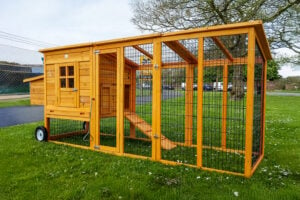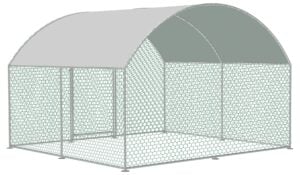What is the best floor for chicken coops?
Many flooring options are good for your chicken coops. The most common is wood which is great, just make sure it stays dry and does not have any chemicals on it. Always provide ample bedding for your birds such as hay or pine littler which are available at feed stores.
Where do I position my chicken coop in my backyard?
Ideally, you want a quiet corner or spot on your property that is away from your house. It needs to be preferably on a high, well-drained area. You want ample air movement without a draft. Fresh air means fresh oxygen and movement to remove excess moisture, ammonia, and carbon dioxide which hens naturally give off.
It should be an area where the south sun reaches the chicken coop, and the outside pen for a large portion of the day.
How tall should the side fences be on the chicken yard? Is 6 feet sufficient?
Six feet is a common level for poultry fencing. 6 feet would be sufficient in most cases. There have been cases of chickens flying out even at that level, however.
What is the best material to spread on the coop floor?
Sand and saw dust works very well and can be used in wet and dry climates.
How much space do I need in my chicken house and run?
Inside 1 sqft minimum of floor space is good and outside 4 sqft is good. Please bear in mind that chickens like to huddle up at night. Will painting the interior of the coop cause any health risk to the hens? If the paint is non toxic, and well dried, with good ventilation, it should cause no harm to the hens.
How many nest boxes do I need?
Generally, 1 nesting area for every 2 hens.
What’s the White Stuff on My Coop or Hutch?
If you notice a fuzzy white layer on your chicken coop or hutch, you might assume it’s mould or mildew—but that’s not always the case. This white residue, known as fatty bloom, comes from the natural oils and waxes in the protective paint used on the wood. These oils rise to the surface after packaging and can create a powdery or crystal-like appearance.
This is completely normal and harmless. It does not affect the durability or safety of your coop and can be easily wiped away with a dry or slightly damp cloth. Over time, exposure to air and natural weathering will make it disappear on its own.
Is It Toxic?
No, fatty bloom is not toxic and poses no harm to your chickens, rabbits, or other pets. It is simply a natural reaction of the protective oils in the wood paint. If you prefer, you can wipe it off or let it fade naturally over time.
Product Maintenance:
Our wooden coops & runs are pre-treated with an animal-safe preservative for the first 4 weeks. Clean weekly and reapply wood treatment twice a year, ideally before and after winter. Apply waterproofing within the first month or before heavy rain, focusing on roof edges and joints. Use rust remover and rust-proof paint on the wire. Keep the coop in a sheltered area to protect it from harsh weather. We do not accept claims for products that are not maintained or protected. Always use non-toxic, animal-safe treatments.




